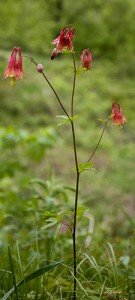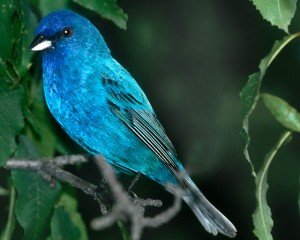Summer events at the river offer opportunities for stewardship & fun
By MARGIE O’LOUGHLIN
The Mississippi River Gorge is an oasis of limestone bluffs, natural springs, oak savanna and remnant hardwood forest. It was carved by St. Anthony  Falls over 10,000 years ago and extends from near Downtown Minneapolis to Crosby Park in St. Paul. Longfellow is right in the middle, and there are a number of groups partnering to keep the Gorge healthy.
Falls over 10,000 years ago and extends from near Downtown Minneapolis to Crosby Park in St. Paul. Longfellow is right in the middle, and there are a number of groups partnering to keep the Gorge healthy.
PHOTO: Prairie Oak Savanna is a grassland where the over-story of oaks form an open canopy. (Photo by Margie O’Loughlin)
The River Gorge Committee (RGC) of the Longfellow Community Council is one of those groups. A group of about 30 people gathered May 9 at the Prairie Oak Savanna, located at 36th St. and W. River Pkwy. With binoculars in hand, they listened to Lyndon Torstenson, co-director of the RGC and manager of Educational Partnerships for the National Park Service, introduce this year’s leaders for the annual spring migration bird walk.
 PHOTO: Early morning bird walk with neighborhood experts at the Prairie Oak Savanna. (Photo by Margie O’Loughlin)
PHOTO: Early morning bird walk with neighborhood experts at the Prairie Oak Savanna. (Photo by Margie O’Loughlin)
Co-leader Dave Zumeta’s first words were, ”Did you hear that bzz bzz bzz? That’s the Golden Winged Warbler!” Co-leader Lee Pfannmuller added, “and Minnesota is home to 48% of the global population of Golden Winged Warblers.” These two have keen eyes and ears and shared a wealth of information about the many birds seen on the three-hour walk.
What other events are happening at the Gorge this summer?
The RGC will partner with Friends of the Mississippi River (FMR) to host the Share the River Gorge Ice Cream Social on Wed., July 29 from 6-8pm. The hub of activity will be the overlook near 35th St. and W. River Pkwy. Plan to take the nearby limestone steps at 34th St. down to the water, and enjoy a paddle in one of Wilderness Inquiry’s 24’ long Voyageur canoes.
RGC meetings take place on the second Wednesday each month (June 10) at Hiawatha Park School from 6:30-8pm. The committee, which has been going strong for 20 years, exists to engage residents of Greater Longfellow with the River Gorge and its care. “We have a world-class resource right here in our neighborhood,” Torstenson said. The RGC is made up of volunteers and is open to anyone who appreciates this urban stretch of the mighty Mississippi.
The Prairie Oak Savanna, where the bird hike took place, is one of the gems of the River Gorge. Ten years ago it was a tangled mess of buckthorn, garlic mustard, litter and overgrowth--until the Gorge Stewards got their hands on it. Sue Rich, volunteer coordinator for FMR, said, “With the contribution of hundreds of volunteers and thousands of hours, we’ve been able to restore this area to its natural state.”
 PHOTO: Columbine is one of many species of native flowers growing in the Prairie Oak Savanna. (Photo by Margie O’Loughlin)
PHOTO: Columbine is one of many species of native flowers growing in the Prairie Oak Savanna. (Photo by Margie O’Loughlin)
There are at least three Gorge Steward programs each year at the Prairie Oak Savanna, including an Earth Day Clean-Up, an educational event in May and a Fall Buckthorn Pull. Email srich@fmr.org to get on the email list for upcoming events.
How does an ordinary person become a Gorge Steward?
The first requirement is to care about the River Gorge, and the second is to attend on or more of the hands-on or educational events sponsored by FMR. Typical activities include pulling buckthorn, monitoring invasive species, planting natives, collecting prairie seeds, cleaning up litter, or participating in natural history or plant identification walks.
There’s a good chance that RGC will schedule a fall migration bird outing, and Sept. 12 is the date being proposed. Check the LCC website in August to register, and request binoculars if you don’t own them. Even if you’re not a birder, consider coming along.
As Torstenson said, “We sit here in Longfellow with a front row seat to the natural world. The birds that surround us are a connection to Mexico and Central America, even to the Arctic, through their paths of migration.”
By MARGIE O’LOUGHLIN
 Since its successful restoration, the Prairie Oak Savanna has become a nesting site for a large number of Indigo Buntings. The adult female is brown with no distinctive markings, but the adult male is unmistakable: a small bird (warbler-sized at 5 ½ inches) with vibrant blue feathers.
Since its successful restoration, the Prairie Oak Savanna has become a nesting site for a large number of Indigo Buntings. The adult female is brown with no distinctive markings, but the adult male is unmistakable: a small bird (warbler-sized at 5 ½ inches) with vibrant blue feathers.
Like blue jays, the male buntings don’t have blue pigment in their feathers. They’re black birds, but sunlight refracts inside the structure of their feathers - making them appear blue. In direct sunlight, they shimmer. Indigo Buntings sing all day long into the heat of the summer.
PHOTO: The Indigo Bunting. (Photo courtesy of Carrol Henderson, DNR)
Comments
No comments on this item Please log in to comment by clicking here